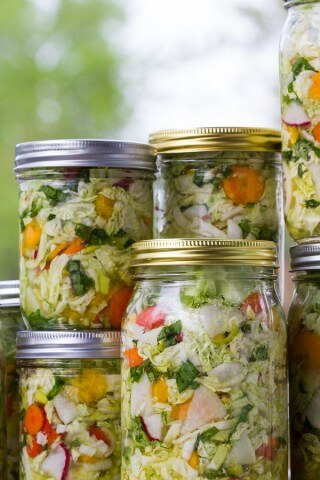New research is continuing to prove that probiotic benefits and side effects go far beyond what we previously thought.
In this complete probiotic guide you will learn everything you would ever need to know about probiotics including the top 10 probiotic foods, best probiotic supplements and how to use them.
New research is continuing to prove that probiotic benefits and side effects go far beyond what we previously thought.
In order to improve your gut flora balance, make sure to avoid the probiotic killers. We are exposed to many of these foods, toxins and stressors on a daily basis, and if you’re going to restore your digestive health, they must be addressed.
Most people, including children, are in need of a probiotic boost due to the use of prescription medication particularly antibiotics as well as high carbohydrate diets, the consumption of chlorinated and fluoridated water, and conventional foods such as non-organic meat and dairy that contain antibiotic residues.
These chemicals kill off probiotics in your system, which over time will damage your digestive tract.
New research is continuing to prove that probiotic benefits and side effects go far beyond what we previously thought.
In order to improve your gut flora balance, make sure to avoid the probiotic killers. We are exposed to many of these foods, toxins and stressors on a daily basis, and if you’re going to restore your digestive health, they must be addressed.
If they’re not addressed, your gut micro-organisms become imbalanced and your system can become a breeding ground for bad bacteria, yeast, viruses, fungi and parasites.
The only way to fix this issue and heal your gut is to eliminate the foods that feed bad bacteria and to start consuming probiotic-rich foods and supplements
Most people, including children, are in need of a probiotic boost due to the use of prescription medication particularly antibiotics as well as high carbohydrate diets, the consumption of chlorinated and fluoridated water, and conventional foods such as non-organic meat and dairy that contain antibiotic residues.
These chemicals kill off probiotics in your system, which over time will damage your digestive tract.
The Top 7 Probiotic Killers include:
- Prescription Antibiotics
- Sugar
- Tap Water
- GMO Foods
- Grains
- Emotional Stress
- Chemicals and medications
In order to improve your gut flora balance, make sure to avoid the probiotic killers.
We are exposed to many of these foods, toxins and stressors on a daily basis, and if you’re going to restore your digestive health, they must be addressed.
If they’re not addressed, your gut micro-organisms become imbalanced and your system can become a breeding ground for bad bacteria, yeast, viruses, fungi and parasites.
We are exposed to many of these foods, toxins and stressors on a daily basis, and if you’re going to restore your digestive health, they must be addressed.
If they’re not addressed, your gut micro-organisms become imbalanced and your system can become a breeding ground for bad bacteria, yeast, viruses, fungi and parasites.
The only way to fix this issue and heal your gut is to eliminate the foods that feed bad bacteria and to start consuming probiotic-rich foods and supplements.
20 Probiotic Benefits Proven by Research
The strongest evidence to date finds that probiotic benefits include:
- boosting immune system

- prevent and treat urinary tract infections
- improve digestive function
- heal inflammatory bowel conditions like IBS4
- manage and prevent eczema in children
- fight food-borne illnesses
New studies underway may soon prove that probiotics can:
- reduce flu and colds
- reduce overuse of antibiotics
- treat kidney stones
- treat colic
- prevent cavities and gum disease
- treat colitis and Crohn’s disease
- combat antibiotic-resistant bacteria
- treat liver disease
- battle cancer5
- manage autism
- lower cholesterol
- fight bacteria that causes ulcers
- improve acne
- lose weight
Are There Probiotic Side Effects?
Probiotic side effects can sometimes include diarrhea if you take too much too fast. You can start off with a smaller amount like one tablespoon of kefir or one probiotic capsule a day and work your way up.
But overall, the side effects of probiotics are nothing but positive!
How Probiotics Work
Your gut contains both beneficial and harmful bacteria. Digestive experts agree that the balance of gut flora should be approximately 85 percent good bacteria and 15 percent bad bacteria.
If this ratio gets out of balance, the condition is known as dysbiosis, which means there is an imbalance of too much of a certain type of fungus, yeast or bacteria that is affecting the body in a negative way. By consuming certain types of probiotics foods and supplements you can help bring these ratios back into balance.
Also, it is important to understand that probiotics are not a new idea. Throughout history, cultures have thrived on probiotics found in fermented and cultured foods, which were invented for food preservation long before the refrigerator.
In fact, the refrigerator could be one of the worst inventions for your digestive health because now we don’t have to culture or ferment our foods to keep them from spoiling so we lose out on those vital probiotics.
Health Benefits of Probiotic Foods
“Every traditional culture, when you look at their traditional diet, they ferment their foods. They fermented everything. You can ferment dairy, grains, beans, vegetables, fruits, meats, and fish. Everything can be fermented, and there were fermented beverages in every culture. When the cabbages were ripe in September, you made it a fermented cabbage.
Perhaps for a month or two, you were eating fresh cabbage, but then for the rest of the year, 10 months of the year, you ate your cabbage in a fermented form. Quite a large percent of all the foods that people consume on a daily basis were fermented. And with every mouthful of these fermented foods you consume trillions of beneficial bacteria;”
Fermented foods have been consumed for over 5000 years and even in the past 100 years certain cultures have excelled on probiotic rich foods.
Germans consumed sauerkraut, Indians consumed lassi, Bulgarians consumed kefir, Asians cultures consumed kimchi, Russians consumed raw yogurt, and Kenyan’s consumed amasi.
Fermented foods give you way more units of probiotics and strains of probiotics than a supplement ever will. When Dr. McBride tested the fermented vegetables, she found that her vegetables had trillions of probiotic units and over 30 strains, which means her one serving of fermented vegetables was equal to an entire bottle of probiotics.
Dr. McBride also states that, “Nature is extremely wise and populated all organic fruit and vegetables, the dust on our soils, and all plant matter with Lactobacilli. The fresh cabbage leaves, if it’s organically grown (not the one from chemical farming), will be covered in Lactobacilli lacto-fermenting bacteria. You don’t need to add anything. You just chop it up. Add some salt in the initial stages. (The salt is added in the initial stage in order to stop putrefactive bacteria from multiplying.) Then as the Lactobacillus stop working and start multiplying, they produce lactic acid. That’s why they’re called Lactobacillus. That’s just lactic acid.
If you look at the research in lactic acid, it is one of the most powerful antiseptics. It kills off lots and lots of bad bacteria…. So as the lactic acid starts producing, it will kill off all those putrefactive and pathogenic microbes and preserve the food. It’s a great preservative… A good batch of sauerkraut can keep for five to six years without spoiling or rotting, as long as it is covered by its own juice.”
This process of fermentation does even more than preserve your food — it also makes the nutrients in the food more bio-available.
According to Dr. McBride, the amount of bio-available vitamin C in sauerkraut is 20 times higher than in fresh cabbage!6
According to Dr. McBride, the amount of bio-available vitamin C in sauerkraut is 20 times higher than in fresh cabbage!6
One of the other aspects that make the probiotic benefits in fermented foods so amazing is that they also kill off bad bacteria!
The healthy bacteria, or probiotics, live longer than the unhealthy ones and actually help to end the bad bacteria reign in the gut.
This decrease in “bad bacteria” like candida and h. pylori naturally benefits the body with less illness and diseases and lower rates of inflammation.
Top 10 Probiotic Foods ListThis decrease in “bad bacteria” like candida and h. pylori naturally benefits the body with less illness and diseases and lower rates of inflammation.
If you want to start consuming probiotic-rich foods, here is a list of the most beneficial probiotic foods:
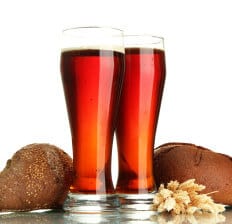 #7 Kvass
#7 Kvass
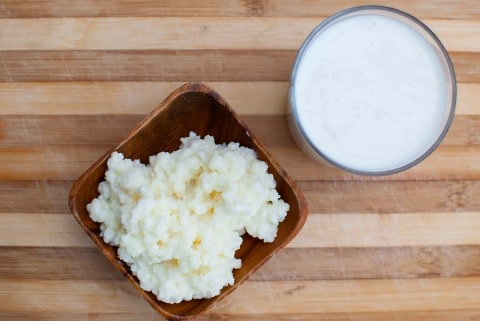 #1 Kefir
#1 Kefir
Similar to yogurt, this fermented dairy product is a unique combination of milk and fermented kefir grains.
Kefir has been consumed for well over 3,000 years, and the term kefir was started in Russia and Turkey and means “feeling good.”
Kefir has been consumed for well over 3,000 years, and the term kefir was started in Russia and Turkey and means “feeling good.”
Kefir is created by the fermentation of milk by the bacteria, and yeasts in kefir starter breaks down lactose in the milk. That is why kefir is suitable for those who are otherwise lactose intolerant.
It has a slightly acidic and tart flavor and contains anywhere from 10 to 34 strains of probiotics. Kefir is similar to yogurt, but because it is fermented with yeast and more bacteria the final product is higher in probiotics.
If you want to learn more, check out this article on how kefir benefits your health.
 #2 Sauerkraut
#2 Sauerkraut
Made from fermented cabbage and other vegetables, sauerkraut is not diverse in probiotics, but is high in organic acids (what gives food its sour taste) that support the growth of good bacteria. Sauerkraut is extremely popular in Germany today.
Sauerkraut is high in vitamin C and digestive enzymes. It is also a good source of natural lactic acid bacteria such as lactobacillus.
Sauerkraut juice has been studied to benefit digestive issues like leaky gut, diarrhea and constipation, and is also effective at helping you kick a cold fast.
Sauerkraut juice has been studied to benefit digestive issues like leaky gut, diarrhea and constipation, and is also effective at helping you kick a cold fast.
 #3 Kimchi
#3 Kimchi
Kimchi is a cousin to sauerkraut and is the Korean take on cultured veggies.
It is created by mixing a main ingredient such as chinese cabbage with a number of other foods and spices, like red pepper flakes, radishes, carrots, garlic, ginger, onion, sea salt and fish sauce. The mixture is then left aside to ferment for 3-14 days.
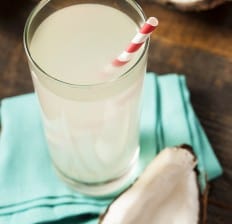 #4 Coconut Kefir
#4 Coconut Kefir
Made by fermenting the juice of young coconuts with kefir grains. This dairy-free option for kefir has some of the same probiotics as traditional dairy kefir but is typically not as high in probiotics. Still, it has several strains that are great for your health.
Coconut kefir has a great flavor and you can add a bit of stevia, water and lime juice to it and make a great tasting drink.
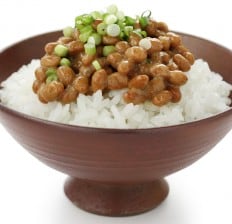 #5 Natto
#5 Natto
A popular dish in Japan consisting of fermented soybeans. Natto contains the extremely powerful probiotic bacillus subtilis, which has been proven to bolster your immune system, support cardiovascular health and enhance digestion of vitamin K2.
Natto can also contain vitamin B12, which is lacking in vegan diets and is one of the highest plant-based sources of protein at 17.7 grams per 100 gram serving size.
#6 Yogurt
Possibly the most popular probiotic food is live cultured yogurt or greek yogurt made from the milk of cows, goats or sheep.
Yogurt in most cases can rank at the top of probiotic foods if it comes from raw grass-fed animals. The problem is there is a large variation on the quality of yogurts on the market today. It is recommend when buying yogurt to look for three things. First, that it comes from goat’s, sheep milk or A2 cows milk; second, that it is grass-fed; and third, that it is organic.
 #7 Kvass
#7 Kvass
Kvass is a common fermented beverage in Eastern Europe since ancient times. It was traditionally made by fermenting rye or barley, which gives it its mild flavor. In more recent years it has been created using beets, fruit, along with other root vegetables like carrots.
Kvass uses lactobacilli probiotics, which have blood- and liver-cleansing properties.
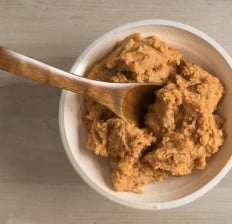 #8 Miso
#8 Miso
Miso is one the mainstays of traditional Japanese medicine and is commonly used in macrobiotic cooking as a digestive regulator. Miso has been a staple in Chinese and Japanese diets dating back approximately 2,500 years.
Today, most of the Japanese population begins their day with a warm bowl of miso soup believed to stimulate the digestive system and energize the body.
Made from fermented soybeans, rice or barley, adding a tablespoon of miso to some hot water makes an excellent, quick, probiotic-rich soup.
The fermentation process can take anywhere from a few days to a couple of years to complete and the end result is a red, white or dark brown colored paste with a buttery texture.
Miso soup is famous throughout the world and it is very easy to prepare. Simply dissolve a tablespoonful of miso in a pot of water filled with seaweed and other ingredients of your choice.
#9 Kombucha
Kombucha is an effervescent fermentation of black tea that is started by using a SCOBY, also known as a symbiotic colony of bacteria and yeast. Kombucha has been around for over 2,000 years and was thought to originate in 212 B.C. in the Far East. It later surfaced in Japan and then spread to Russia.
Many claims have been made about kombucha, but its primarily health benefits include digestive support, increased energy and liver detoxification.
Read more here on the health benefits of kombucha.
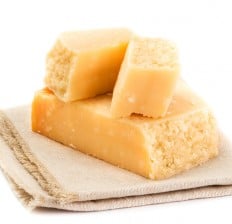 #10 Raw Cheese
#10 Raw Cheese
Goat’s milk, sheep’s milk and A2 aged cheeses are particularly high in probiotics, including thermophillus, bifudus, bulgaricus and acidophilus. Always buy raw and not pasteurized or you will not be getting any of the probiotic benefits.
How to Pick the Best Probiotic Supplements
It’s important to note that there are different types of strains of probiotics. The probiotic benefits experienced with one probiotic strain may be completely different from the health benefits seen from another probiotic.
Certain strains of probiotics support immunity, others digestion, and some even help burn fat and balance hormones.
If you want to use probiotics to help with a specific health concern, it’s vital to select the right probiotic for the right condition. Or, consume a wide range of probiotics in your food and you will be covered.
As we said earlier, you are what you digest and there are no other compounds in the world that support digestion and the assimilation of nutrients better than living probiotics. While many companies are now producing probiotics, the majority of them are ineffective at best. Most probiotic supplements today are destroyed by your stomach acid before they ever get to your digestive tract.
When reading a probiotic label, it should reveal the genus, species and strain of the probiotic.
The product should also give you the CFU’s (colony forming units) at the time of manufacturing.
Also, the majority of probiotics can die under heat so knowing the company had proper storing and cooling of the facility is also important.
There are five specific things you want to consider when buying a probiotic supplement:
- Brand Quality — look for brands that are reputable like Garden of Life, MegaFood and Axe Naturals.
- High CFU Count — purchase a probiotic brand that has a higher number of probiotics from 15 billion to 100 billion.
- Strain Diversity — search for a probiotic supplement that has 10-30 different strains.
- Survivability — look for strains like bacillus coagulans, saccharomyces boulardii, bacillus subtilis, lactobacillus rhamnosus, and other cultures or formulas that ensure probiotics make it to the gut and are able to colonize.
- Research — do your homework and look for brands that have strains that support your specific needs. You can find specific strain benefits in this chart below:
Best Probiotic Brands and Supplements
Again, to get the most probiotic benefits, it is important to get a balanced source of probiotics with many different strains. If you want to know the best probiotic supplements that I have personally taken in the past year, here are my top three:
1. Axe Naturals LIVE Probiotics — the brand I personally formulated that contains all of the above researched probiotics plus rare and unique prebiotics. This high-quality probiotic formula has both SBO (heat resistant soil based organisms) and food based probiotics to give you the best of both worlds.
2. Garden of Life Primal Defense — This is an excellent probiotic formula that contains a great strain in bacillus subtilis.
3. Prescript Assist — an SBO probiotic supplement that contains a wide range of organisms. This supplement has become more popular over the years because of its many soil-based strains.
Action Steps:
- Do your best to remove substances that can destroy probiotics, like sugar, grains, GMOs, tap water, antibiotics, and emotional stress from your life.
- Consume two servings daily of probiotic-rich foods from the top 10 list.
- Take a probiotic supplement that has at the very least 10+ strains of probiotics with at least 15 billion CFUs.
https://draxe.com/probiotics-benefits-foods-supplements/
Don't miss these other health stories:
Benefits of Probiotics for Your Pet
Don't miss these other health stories:
Benefits of Probiotics for Your Pet


